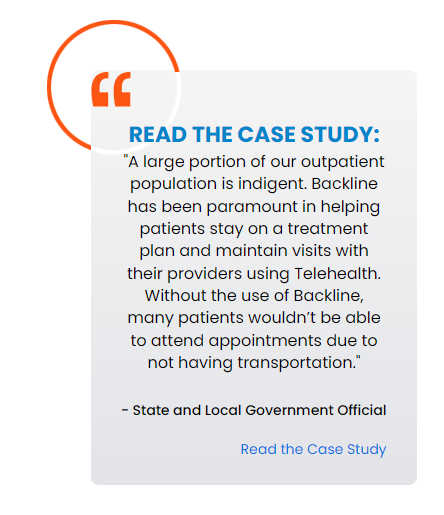The Power of Telemedicine: Transforming Healthcare with Technology

Telemedicine and telehealth are reshaping the way healthcare services are delivered. Telemedicine bridges the gap between medical professionals and patients, empowering individuals to access high-quality healthcare conveniently. As medical and clinical professionals, you know this technology plays a vital role in bringing healthcare directly to your patients' fingertips, regardless of their location or mobility.
Technology acts as the backbone of telemedicine, making it all possible. Through video conferencing, online portals, and mobile apps, patients can connect with healthcare providers easily from the comfort of their homes. By utilizing telehealth, healthcare providers can virtually examine patients, review medical records, prescribe medication, and monitor ongoing treatment.
Read this Case Study of a State & Local Government Survey of customers by TechValidate.
Telemedicine eliminates the need for unnecessary travel, long wait times, and costly hospital visits. It improves access to healthcare (particularly for rural or underserved populations), enhances patient outcomes, and lowers costs, making it a win-win solution for both patients and healthcare providers.
In this article, we explore how to embrace the transformative power of telemedicine and discover how technology is advancing healthcare delivery, making it more accessible and convenient for providers and their patients.
Telemedicine Services and Platforms
Telemedicine services and platforms are vital components in modern healthcare, offering an array of remote healthcare services that redefine the traditional patient-care model.
Remote Healthcare Services
Remote healthcare services offer convenient access to medical care without the need for in-person visits. These services typically utilize telecommunication technologies to connect patients with healthcare professionals for consultations, monitoring, and educational services.
Even though we are past the COVID-19 pandemic, the effects are still felt throughout the healthcare community. Since the COVID-19 pandemic, remote healthcare services have become a critical component of provider-to-provider communication.
One of the biggest advantages of accessing healthcare remotely is convenience. Patients can receive medical attention from the comfort of their own homes. Remote healthcare services also provide patients with access to healthcare services when they might otherwise be difficult to receive.
These are some examples of remote healthcare services in practice:
- Online consultations with doctors
- Prescription refill services
- Telepharmacy for medication management
By eliminating the need for travel and reducing administrative overhead, remote healthcare services can result in cost savings for both patients and healthcare providers.
Virtual Doctor Visits
At the heart of these services are virtual doctor visits and advanced telehealth technology, epitomized by platforms like Backline by DrFirst. Virtual doctor visits, also known as telehealth visits, involve remote consultations between patients and healthcare providers through video calls and secure messaging platforms. This mode of consultation is particularly beneficial in managing chronic conditions, mental health, and routine follow-ups.
If an in-person appointment is deemed necessary, a remote team can admit patients, reducing the burden on staff on-site. Team coordination and communication take place in a Backline virtual workspace. A scheduling app integrated with Backline ensures the on-call remote nurse is notified of new admission orders. Nurses can track when the video call was placed, and when the admission was completed.
These are some other benefits of virtual doctor visits for patients:
- Convenience and flexibility in scheduling appointments
- Reduced travel time and expenses
- Increased access to specialists and expert opinions
- Improved continuity of care
Additionally, the technology powering these services, like Backline by DrFirst, integrates tools for secure communication and efficient patient data storage.
Features of Backline Health by DrFirst for Telemedicine:
- Secure and HIPAA-compliant communications platform with adaptive workflows
- Real-time video consultations
- Integration with electronic health records (EHR systems) and prescription ordering and management
- Patient follow-up and care coordination across multiple care teams and family members - no matter their location and without downloading an app
Telehealth Technology
Telehealth technology not only supports the clinical aspects of healthcare delivery but also enhances the operational efficiency of these practices. This technological infrastructure is crucial in maintaining the quality of patient care, ensuring data security, and facilitating seamless interaction between patients and providers.
Role of telehealth technology in improving patient care:
- Facilitates remote consultations and diagnosis
- Supports telemedicine platforms and apps
- Enhances communication and collaboration between healthcare providers
Patients expect a great telehealth experience that follows them anywhere. Using Backline to connect with patients results in better outcomes and reduced costs. With Backline, patient care teams can drive and control the entire telehealth process and use the latest technology tools seamlessly with current on-site patient workflows.
Medical Consultations through Video Calls
Medical consultations via video calls allow for doctor-patient interactions without any physical meeting. This technology has transformed healthcare delivery by overcoming geographical barriers and ensuring timely access to medical expertise.
How video calls enhance doctor-patient communication:
- Visual cues enable better assessment and understanding of patient conditions
- Instant communication promotes real-time discussions and clarifications
- Improved patient engagement and satisfaction with personalized care
Here is an example of someone using telehealth for a doctor's visit:
Sara woke up with a sore throat and cough. She didn't want to drag herself into the doctor's office if it was just a minor cold. Remembering her doctor's office now offered telehealth appointments, Sara logged onto their patient portal on her phone. She was able to easily schedule a same-day virtual visit. When it was time for her appointment, Sara clicked the link and was connected to Dr. Smith through a video call. Dr. Smith asked about Sara's symptoms and allowed her to show areas of her throat through the camera.
Based on Sara's description and what she could see, Dr. Smith believed it was a minor viral infection and not strep throat. She advised Sara to rest, drink plenty of fluids, and take over-the-counter medications. Dr. Smith also reminded Sara about follow-up care if her symptoms didn't improve in a few days.
The entire visit only took about 15 minutes. Sara appreciated the convenience of a virtual appointment, so she didn't have to take extra time off work. She felt well taken care of from the comfort of her home.
Telemedicine Platforms and Apps
Telemedicine platforms and apps serve as comprehensive solutions for delivering telehealth services. They provide features and functionalities that facilitate remote consultations and patient management.
Telehealth as a part of a robust healthcare communications platform can ensure patient care and interaction is not limited to within the walls of hospitals or offices. Telehealth, in particular, can be embedded into EMR workflows, patient portal sites, practice management software, or be used as a stand-alone technology to streamline processes.
Also, patients are becoming more accustomed to digital solutions for various aspects of their lives, including healthcare. Offering telehealth services aligns with the preferences of many patients and can contribute to higher patient satisfaction rates. Engaging patients and families in the healthcare journey is crucial for successful outcomes. Telehealth offers patients greater convenience and flexibility in managing their healthcare needs.
Here are some necessary features and functionalities needed in telemedicine platforms:
- Secure messaging and video conferencing
- Appointment scheduling and reminders
- Integration with EHR and patient health record management
- Prescription ordering and e-prescribing
- Integration with laboratory and diagnostic services
Get a demo of the Backline Health by DrFirst clinical communication platform.
Telemedicine in Specific Contexts
Let’s take a look at how telemedicine is impacting patients and healthcare providers in different contexts.
Telemedicine in Rural Areas
Accessing healthcare in rural areas presents several challenges. Limited availability of medical facilities and healthcare professionals, long travel distances, and lack of transportation options can make it difficult for individuals in rural areas to receive timely and quality healthcare.
However, telemedicine plays a crucial role in addressing these gaps. Through telemedicine, individuals in rural areas can access medical consultations and even receive treatment without the need for travel. Several telemedicine initiatives have proven to be successful in rural regions. For example, the use of telemedicine in providing mental health services to individuals in remote areas has shown great promise. By leveraging telepsychiatry, patients can receive counseling and therapy sessions from licensed professionals without having to travel long distances.
Telemedicine Reimbursement and Insurance Coverage
Understanding telemedicine reimbursement policies is important for both healthcare providers and patients. The rules surrounding telemedicine reimbursement can vary depending on the specific state and insurance provider.
Insurance coverage for telemedicine services has been expanding in recent years. Many insurance plans now provide coverage for telemedicine consultations and treatments, making these services more accessible to patients. Case studies on telemedicine reimbursement models have shown positive outcomes. By developing effective reimbursement strategies, healthcare providers can ensure they are appropriately compensated for their telemedicine services, while patients can benefit from reduced out-of-pocket expenses.
Telemedicine Benefits and Challenges
Telemedicine offers numerous benefits for patients and healthcare providers. Patients can enjoy the convenience of receiving healthcare services from the comfort of their own homes, saving time, and reducing travel costs. Healthcare providers can expand their reach and provide care to a larger patient population without the limitations of physical locations.
However, telemedicine also poses certain challenges and limitations. One of the main concerns is ensuring the privacy and security of patient information during telemedicine consultations. Additionally, not all medical conditions can be adequately addressed through telemedicine, as certain procedures and examinations require in-person assessments.
Despite these challenges, the future of telemedicine holds great potential. Advancements in technology and increased adoption of telemedicine are expected to further transform healthcare delivery, improving access, and quality of care.
Transforming Healthcare through Telemedicine
As you can see, telemedicine has proven to be an invaluable tool in revolutionizing healthcare. Throughout this article, we have explored various aspects of telemedicine and its impact on patient care.
Key points discussed include the convenience and accessibility of telemedicine services and platforms, which have greatly enhanced the delivery of healthcare. By leveraging technology, healthcare providers can effectively reach patients in remote areas, reducing barriers to access and improving overall patient care.
Looking towards the future, telemedicine holds significant potential for further advancements. As technology continues to evolve, we can expect to see refined telemedicine platforms with enhanced features and capabilities. This will enable healthcare providers to offer an even higher level of care, particularly in underserved areas.
With the demonstrated benefits and potential of telemedicine, it is crucial to encourage its adoption and implementation in healthcare. By integrating telemedicine into existing healthcare systems, we can improve access to healthcare services, reduce healthcare costs, and enhance patient outcomes.
We invite you to learn more about Backline by DrFirst. Backline offers a comprehensive platform that streamlines telemedicine services, allowing healthcare providers to seamlessly connect with patients virtually. Experience the future of healthcare today with Backline by DrFirst.



.jpg?width=352&name=pexels-cottonbro-studio-7579827%20(1).jpg)
